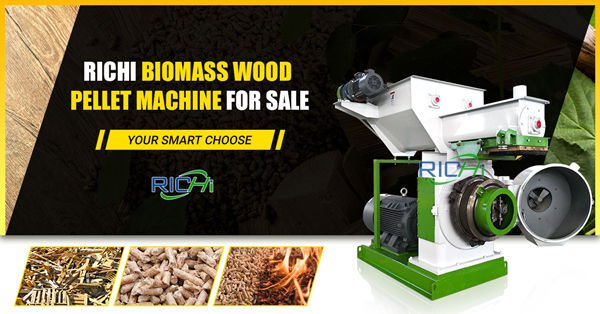Biomass pellet production machinery is a crucial component of the renewable energy industry, transforming various biomass materials into high-density pellets used for energy generation, animal feed, and other applications. To maximize performance and efficiency, it is vital to configure the machine’s components effectively. This article examines the essential components of biomass pellet production machinery and outlines strategies to optimize their configuration for improved production efficiency and pellet quality.
1. Key Components Overview
A biomass pellet production machine comprises several critical components, each playing a significant role in the production process:
- Feeding System: Controls the flow of raw materials into the machine.
- Crusher: Reduces the size of biomass materials to facilitate efficient processing.
- Conditioner: Introduces moisture and heat to the raw materials, enhancing binding properties.
- Pellet Mill: Compresses the conditioned biomass into pellets using a die and rollers.
- Cooling System: Lowers the temperature of the pellets post-formation to stabilize their structure.
- Screening System: Eliminates fines and ensures uniform pellet size.
- Packaging System: Packages the finished pellets for storage or distribution.

2. Optimizing the Feeding System
The feeding system is crucial for ensuring a steady flow of raw materials into the pellet machine.
- Type of Feeder: Select a feeder suited to the characteristics of the biomass being processed. Screw feeders are effective for fibrous materials, while belt feeders may be more suitable for bulkier materials.
- Adjustable Feed Rate: Implement a feeder with an adjustable feed rate to accommodate variations in raw material density and moisture content. This flexibility helps maintain a steady material flow, preventing fluctuations that could compromise pellet quality. (Related post:biomass pellet mill for sale)
3. Enhancing Crusher Performance
The crusher is essential for reducing the size of biomass materials, which is critical for efficient pelleting.
- Size Reduction Efficiency: Choose a crusher capable of reducing biomass to the desired particle size, typically less than 5 mm. A hammer mill with adjustable screen sizes offers versatility in particle size reduction.
- Maintenance and Durability: Opt for a crusher constructed from high-quality materials that can withstand the abrasive nature of biomass. Regular maintenance, including blade sharpening and component inspections, is vital for consistent performance.
4. Improving the Conditioning Process
Conditioning is a crucial step that prepares biomass for pelleting by adding moisture and heat.
- Moisture Control: Utilize a conditioning system that allows precise control of moisture levels. The optimal moisture content for biomass pellets is usually between 10% and 15%.
- Steam Conditioning: Incorporate steam during the conditioning process to enhance the binding properties of the biomass. A well-designed conditioner can improve heat distribution, ensuring uniform conditioning throughout the material.
5. Optimizing the Pellet Mill
The pellet mill is the core component responsible for compressing the biomass into pellets.
- Die and Roller Quality: Invest in high-quality dies and rollers made from wear-resistant materials. The die design, including hole size and distribution, affects the pressure and temperature within the pelleting chamber, influencing pellet quality.
- Pressure and Temperature Control: Maintain optimal pressure and temperature settings during the pelleting process. Monitoring these parameters and making necessary adjustments can enhance pellet density and durability.
6. Enhancing the Cooling System
Cooling is essential for stabilizing the pellets after formation.
- Cooling Efficiency: Use a counterflow cooler for efficient heat exchange, cooling the pellets while minimizing moisture loss. Rapid cooling helps maintain the structural integrity of the pellets, preparing them for packaging.
- Airflow Distribution: Ensure the cooling system provides even airflow distribution across the pellets. Uneven cooling can lead to inconsistencies in pellet quality and moisture content. (Related post:straw pellet press)
7. Optimizing the Screening System
The screening system is responsible for removing fines and ensuring uniform pellet size.
- Screen Design: Implement vibrating screens that enable efficient separation of fines from the finished pellets. The screen design should minimize product loss while ensuring only pellets of the desired size proceed to packaging.
- Regular Maintenance: Regularly inspect and clean the screening system to prevent blockages and ensure optimal performance. A well-maintained screening system contributes to consistent pellet quality.
8. Improving the Packaging System
The packaging system is the final step in the pellet production process, and its efficiency can impact overall productivity.
- Automated Packaging: Invest in automated packaging systems that can quickly and accurately fill, weigh, and seal bags of pellets. Automation reduces labor costs and increases throughput.
- Quality Control in Packaging: Ensure packaging materials are moisture-resistant and durable to protect pellets during storage and transportation. Proper packaging helps maintain pellet quality and reduces spoilage.
9. Implementing Control Systems
Advanced control systems can significantly enhance the overall efficiency of biomass pellet production machinery.
- Real-Time Monitoring: Utilize real-time monitoring systems to track key parameters such as temperature, pressure, and feed rate. This data allows operators to make timely adjustments to optimize the production process.
- Data Analysis: Employ data analysis tools to identify trends and areas for improvement in the production process. Analyzing historical data can help optimize component configurations and enhance overall efficiency.
Conclusion
Optimizing the configuration of biomass pellet production machinery is essential for boosting production efficiency and ensuring high-quality pellets. By focusing on the feeding system, crusher, conditioner, pellet mill, cooling system, screening system, packaging system, and control systems, producers can enhance the performance of their machines and achieve better operational outcomes.
Investing in high-quality components and implementing best practices for maintenance and monitoring will contribute to the long-term success and sustainability of biomass pellet production operations. As the demand for renewable energy sources continues to rise, optimizing the use of biomass materials through effective machine configuration will be critical for maintaining a competitive edge in the market. By prioritizing these optimization strategies, producers can enhance efficiency, reduce costs, and improve the quality of their final products.
